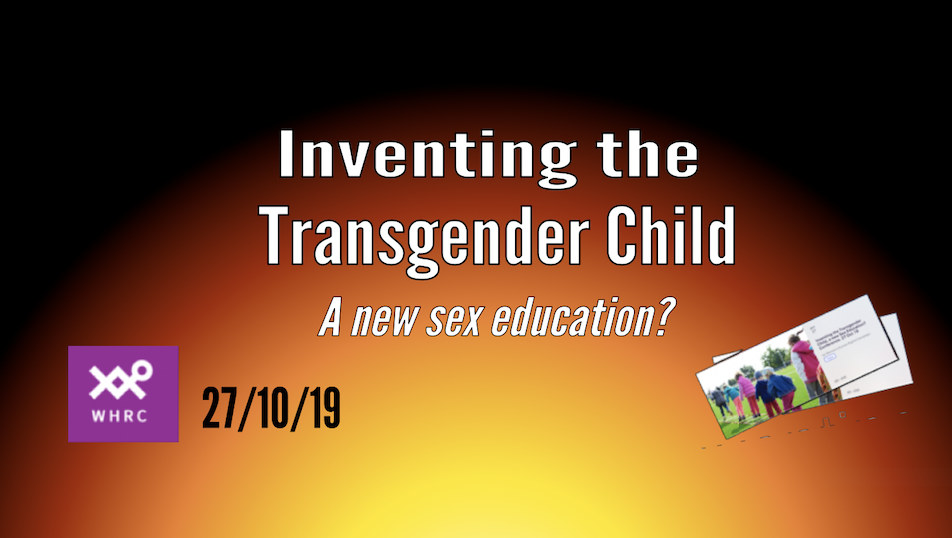
On October 27th 2019, I attended the one-day conference ‘Inventing the Transgender Child – A new Sex Education?‘ in central London.
Tickets went on sale through Eventbrite and that link to the event, with the original details of speakers and timetable, is still available here. Unfortunately, Michele Moore was unable to attend due to illness.
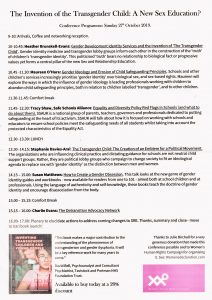
All photos by Lily Maynard.
Inventing the Transgender Child – a new sex education?
Arriving in central London for 8.45am on a Sunday morning is not something I achieve- or aim to achieve- on a regular basis. My ideal Sunday morning awakening time would have been about two hours into the conference, but this one was worth getting up for. Armed with a flask of espresso, an apple and two packets of sweet chilli crisps, I headed for the underground.
The day had begun early for me, but Lesley had cheerfully undertaken a three hour drive to get to town. I’d hoped to go for coffee at Speedy’s Café, as frequented by Holmes & Sherlock in the TV series, but alas, it’s closed on a Sunday so it was a quick trip to the more omnipresent Starbucks while Lesley parked her car.

The conference was organised by the Women’s Human Rights Campaign (WHRC) who have produced a website, and a booklet containing a summary of their Declaration on Women’s Sex-Based Rights. There is a direct link to the Declaration below.
EDIT: 2024 the WHRU is now renamed Women’s Declaration International. The link to the website remainsd the same.
 Although we arrived early, plenty of others were there before us, bright-eyed and bushy-tailed despite the early hour. We registered at the front desk, hung up our coats and took a copy of the programme and a summary of the Declaration on Women’s Sex Based Rights. The hall was already filling up, coats and bags reserving chairs; attendees milling around and drinking the surprisingly palatable coffee provided. For those so inclined there was also chilled still or sparkling water, and a rainbow of tea bag options.
Although we arrived early, plenty of others were there before us, bright-eyed and bushy-tailed despite the early hour. We registered at the front desk, hung up our coats and took a copy of the programme and a summary of the Declaration on Women’s Sex Based Rights. The hall was already filling up, coats and bags reserving chairs; attendees milling around and drinking the surprisingly palatable coffee provided. For those so inclined there was also chilled still or sparkling water, and a rainbow of tea bag options.
The organisers had sensibly allowed an hour of networking time at the start of the conference. Lesley and I munched the crisps, I topped the coffee up with my flask of espresso and we perused our documents, pausing to say hi to familiar faces.
Soon it was time to take our seats: the conference started promptly at 10am, with assurances that there was a tight schedule which needed to be adhered to.
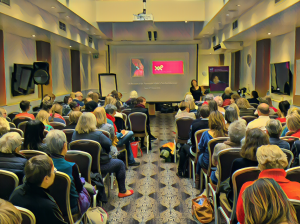
The audience as the talks begin
Introduction
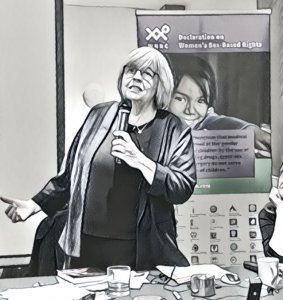 Maureen O’Hara of WHRC introduced herself and reminded us that a summary of the Declaration of Sex Based Rights was available on the registration table and that the full Declaration could be seen and signed on the WHRC website.
Maureen O’Hara of WHRC introduced herself and reminded us that a summary of the Declaration of Sex Based Rights was available on the registration table and that the full Declaration could be seen and signed on the WHRC website.
She thanked Julie Burchill for helping to fund the conference, which was met with applause, and informed us that speaker Michele Moore was ill and unable to attend, which was met with much disappointment.
O’Hara reminded us that women’s rights in human rights law everywhere are based on our experience as a sex, not based on gender identity. She read aloud a section from Article 9 of the Declaration, which reaffirms the need to protect the rights of the child:
“States should recognize that medical interventions aimed at the ‘gender reassignment’ of children by the use as puberty supressing drugs, cross-sex hormones and surgery do not serve the best interests of children. Children are not developmentally competent to give full, free and informed consent to such medical interventions, which carry a high risk of long-term adverse consequences to the physical and psychological health of the child, and which may result in permanent adverse consequences, such as sterility. States should prohibit the use of such medical interventions upon children.”
So far the Declaration had been signed by over six thousand people from 97 countries and is supported by 106 organisations, despite only having been launched in March.
“I’d like to introduce Heather Brunskell-Evans,” concluded O’Hara, ” an academic, philosopher and social theorist with particular interest in the politics of medicine, the sexed body and the cultural construction of gender.”
Heather Brunskell-Evans:
‘Gender Identity Development Services and the invention of ’The Transgender Child’

‘Gender identity medicine and transgender lobby groups inform each other in the construction of the ‘truth’ of children’s ‘transgender identity’. This politicised ‘truth’ bears no relationship to biological fact or progressive values yet forms a central pillar of the new Sex and Relationship Education.’
“The school is now being asked to conspire in the invention of the transgender child, with appalling consequences for children.”
Heather rose, saying she wanted to explain the importance of the shift from sex to gender identity in Sex and Relationship Education. New guidance for both primary and secondary schools comes into place in September 2020. Primary schools will be encouraged to teach LGBT issues and as a part of this and it will be compulsory for secondary schools. The assertion that gender is more ‘valid’ than sex means this teaching focuses not on acceptance of same sex relationships, but rather on the idea of the essence of gender identity.
The Department of Education (DOE) Guide states that it isn’t considered necessary for a child to be taking medicine to ‘change gender’ because its considered to be ‘a personal process not a medical one‘ as long as the child is taking steps to ‘live as the opposite gender or be proposing to do so’.
Brunskell-Evans spoke of the idea of ‘assigned birth sex‘ which suggests that gender identity is something that we are born with. DOE guidelines suggest that it is the child who decides whether they are a boy or a girl. This means, for example, that a boy who declares himself a girl should be allowed to attend a single sex class for girls.
2019 DOE guidance on the new curricula claims the new subjects “represent a huge opportunity to help our children and young people develop … personal attributes including kindness, integrity, generosity, and honesty”.
“These are laudable values.” observes Brunskell-Evans. “However, I argue that the assertion that the new curricula move children forward to a more equal, healthy, and tolerant society is a chimera.
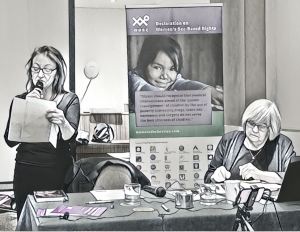 “… the new language of sex and gender which has been developed by lobby groups and which is evolving while we speak… this language justifies that a trans woman is real. Not that he is a male human being who has the right – in my view- to ‘identify’ as female, but that he really IS a woman and has been since birth, ie he was born female… he is a woman, a fact for which he is not responsible and which is transphobic to even question…
“… the new language of sex and gender which has been developed by lobby groups and which is evolving while we speak… this language justifies that a trans woman is real. Not that he is a male human being who has the right – in my view- to ‘identify’ as female, but that he really IS a woman and has been since birth, ie he was born female… he is a woman, a fact for which he is not responsible and which is transphobic to even question…
… this positively requires the invention of the existential transgender child.”
“The invention of the transgender child results in the abuse of children who, as a result of puberty blockers and cross-sex hormones, have their rights to physical health and bodily integrity breached. They face the near certainty of lifelong medical problems, including the reduction of adult sexual pleasure, often replaced by pain, and of course, the really serious issue of sterility… Gender confused children are deprived of their right to adult care.”
How does this state of affairs play out in the new language of gender medicine?
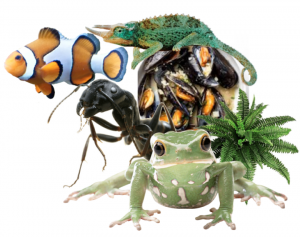 Dr James Barratt, Lead Clinician at the NHS Gender Identity Clinic (GIC) for adults argues that binary sex in the human mammal is ‘less than common sense’.
Dr James Barratt, Lead Clinician at the NHS Gender Identity Clinic (GIC) for adults argues that binary sex in the human mammal is ‘less than common sense’.
“The empirical examples he gives to justify his claim are shameful,” declares Brunskell-Evans, “coming out of the mouth of someone who describes himself as a ‘practitioner scientist’.”
Barratt’s examples are the reproductive variations in plants, molluscs, some insects and amphibians, reptiles and fish.
Heather asserts that idea that sex is socially constructed but gender identity is inherent contributes to the abuse of the rights of all young people: the right to factual knowledge of human biology, to social conditions compatible with mental health, including freedom from the current confusion arising from the adult obsession with ‘gender identity’. The invention of the ‘transgender child’ does not free children from gender stereotypes but binds them ever closer to traditional ideas of what it is to be a girl or a boy.
Teachers and policy makers are not simply being expected to nurture and protect all children and to teach tolerance, they are being induced to join medics and trans lobby groups in the co-creation of the ‘transgender child’.
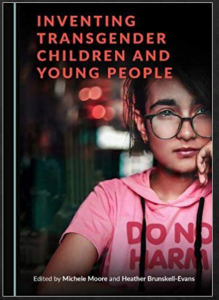 In her book, co-edited with Michele Moore, Brunskell-Evans explores the role of the Tavistock and NHS GIDS close links with lobby groups and their role in inventing the transgender child. The Tavistock promotes not only the idea that a boy can be born with a ‘pink’ brain but that some children, those who are ‘pan’ can have a multiple essential genders. Brunskell-Evans asserts that the adult obsession with transgender identity is not helping the health of children and young adults and damages all children, gender confused or otherwise.
In her book, co-edited with Michele Moore, Brunskell-Evans explores the role of the Tavistock and NHS GIDS close links with lobby groups and their role in inventing the transgender child. The Tavistock promotes not only the idea that a boy can be born with a ‘pink’ brain but that some children, those who are ‘pan’ can have a multiple essential genders. Brunskell-Evans asserts that the adult obsession with transgender identity is not helping the health of children and young adults and damages all children, gender confused or otherwise.
You can purchase a copy of ‘Inventing Transgender Children and Young People‘ here or here. Brunskell-Evans and Moore’s first book, ‘Transgender Children and Young People’ can be purchased here.
Your local library may hold either or both books and if not you can request that they purchase a copy.
You can read the full text of Heather’s notes for the talk here.
Questions
Some time was put aside for questions and discussion. It was raised that the Tavistock had wished to pre-approve the book before publication and had made legal threats which had held up the publication of the book. Party politics reared its head. The Memorandum of Understanding was called “a gagging clause” which stood “against curiosity and examination“. A woman suggested that the works of Piaget and Winnicot were worth revisiting and the ideas of developmental competence needed more exploration. Heather offered that in many areas society doesn’t see children as competent, but in the gender arena exploration is not allowed, exploring other routes and ideas is seen as transphobia and forbidden, if not by the law then by how we conceptualise the idea.
 Sue Evans spoke of the test court case being brought against GIDS that hopes to establish that children cannot give their informed consent to radical experimental medical treatment that includes loss of sexual function and sterility.
Sue Evans spoke of the test court case being brought against GIDS that hopes to establish that children cannot give their informed consent to radical experimental medical treatment that includes loss of sexual function and sterility.
You can read more about this important case and make a donation towards the costs here at www.crowdjustice.com/case/protect-children.
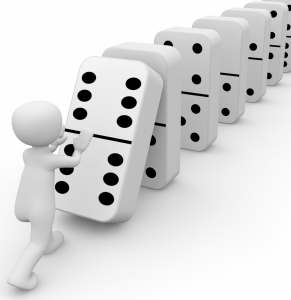 ‘Can doctors really believe this stuff?‘ asked one audience member.
‘Can doctors really believe this stuff?‘ asked one audience member.
Brunskell-Evans said that doctors have expressed concerns, but that ‘they are as afraid as anybody else‘ to speak out. She said she felt optimistic that as more and more people speak up about concerns it will become easier for others, ‘like dominoes falling down’.
 Maureen O’Hara:
Maureen O’Hara:
‘Gender Ideology and Erosion of Child Safeguarding Principles’
Schools and other children’s services increasingly prioritise ‘gender identity’ over biological sex, and sex-based rights. Maureen will explore the ways in which the influence of gender ideology is leading professionals working with children to abandon child safeguarding principles, both in relation to children labelled ‘transgender’, and to other children.
Heather introduced Maureen as a feminist, activist, a legal academic who has worked in child safeguarding and as a solicitor. O’Hara’s research focuses on the sex trade.
“More recently she has been researching the ways in which law and policy relating to gender identity are affecting the sex-based rights of women and girls, which led to her drafting, with myself and Sheila Jeffreys, the Declaration of Women’s Sex-Based Rights.“
 Maureen began by telling us she was going to talk about gender ideology and the erosion of child safeguarding principles. Gender ideology she said, was becoming a dangerous orthodoxy, hard to challenge and equally hard to escape. In International Human Rights Law there has always been a clear distinction between gender and sex: sex is based on Biology.
Maureen began by telling us she was going to talk about gender ideology and the erosion of child safeguarding principles. Gender ideology she said, was becoming a dangerous orthodoxy, hard to challenge and equally hard to escape. In International Human Rights Law there has always been a clear distinction between gender and sex: sex is based on Biology.
Gender, according to IHRL and the WHO, is ‘the roles, behaviours, activities and attributes that a given society, at a given time, considers appropriate for men and women.‘ Thus gender is defined as socially constructed and not innate. Sex is not assigned and cannot be changed.
A group of doctors criticised treatment of trans-identified children in a letter to the Lancet last year, saying ‘sex has a biological basis whereas gender is fundamentally a social expression‘.
“Gender ideology,” said O’Hara, showing us slides based on the ideas of the Yogyakarta Principles,“turns that on its head”.
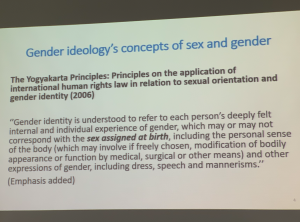
These principles have nothing to do with sexual orientation, but this connection is often made in lobbying strategies. They also have no status within law, but are often said to demonstrate best practice despite undermining female sex-based rights.
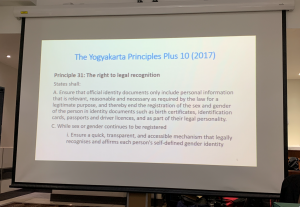
The plus 10 principle makes it clear that the ultimate aim is the eradication of all social and legal markers which denote sex. The Women and Equalities Committee carried out an enquiry into law and policy making around gender identity. They were told that the Yogyakarta principles were best international practise, and recommended self-declaration.
“Which makes me think,” O’Hara added wryly, “that they hadn’t read them, but recommended them anyway.”
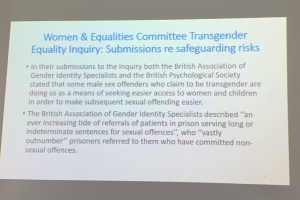
The Ministry of Justice statistics (2018), as explored on BBC Reality Check, concerning this are quite astonishing: of 125 long term prisoners who claimed to be transwomen, 60 were sex-offenders and of those 60, 29 had convictions for sex offences against children.
The World Health Organisation describes violence against women as ‘global health problem of epic proportions’ and the statistics above are likely to be underestimates due to the under reporting of such offences. 2013 WHO research suggests that 33% of women globally have experienced physical or sexual violence at the hands of a man, and that 20% of girls and 8% of boys have been sexually abused.
Sex of perpetrators
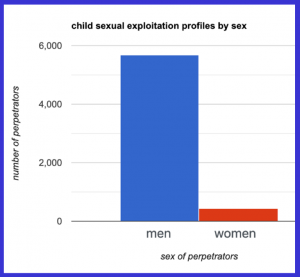
Of 8,806 defendants in sexual offences against children cases, 98% were male.
Police recorded child sexual exploitation profiles published in 2017-18: of 6,107 offenders, 93% were male.
There also appear to be increasing incidents of sexual violence perpetrated by boys against girls, including a shocking 600 rapes over a three year period. Girls are often expected to continue their education in classrooms with the boys who have raped or assaulted them.
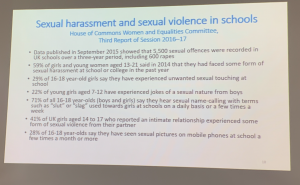
This research makes it clear that sexual assault against girls in schools is not ‘just banter’.
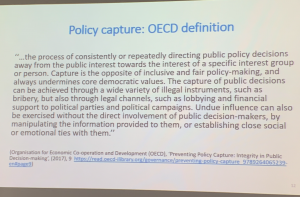
Yet schools are now being encouraged to allow boys to self-identify as girls, giving them access to girls toilets, changing rooms and sleeping facilities on school trips. Self-declaration is not enshrined in law, but has now been introduced by stealth in many organisations: schools, hospitals, refuges, rape crisis centres, even the Girl Guides are all affected. This is achieved through a process of Policy Capture and has a detrimental affect on child safeguarding. This is seen in action when lobby groups such as Mermaids & Stonewall give inaccurate information about the Equality Act.
“In the last five years, universities in the UK have spent £1,000,000 on consultation from Stonewall.”
O’Hara spoke of the 2016 case where a young boy was having a female ‘gender identity’ imposed upon him. He had become isolated and was no longer allowed to mix with children his own age. Social workers had failed to take action. The judge suggested that the social workers “did not wish to appear to be challenging an emerging orthodoxy in such a high profile issue.“
People are scared of being labelled as transphobes. People have lost their jobs for saying men can’t be women and that fear is interfering with professional practice.

O’Hara compared the leaked draft Equality & Human Right Commission document in relation to Scotland and the Allsorts Trans Inclusion Toolkit. Both agree that a child who has been labelled trans should have full access to the facilities that correspond to their gender identity. These policies contravene the Equality Act.
In conclusion, O’Hara referred to the ever-growing-in-popularity of Drag Queen Story Time (DQST).
The LGBT Consortium in the UK says, “the aim is to capture the imagination and fun of the gender fluidity of childhood while giving children a glamorous, positive and unabashedly queer role.” By queer, they don’t mean lesbian or gay, but are referring to Queer Theory. O’Hara asserts that this is in direct contrast to the claim that there is no intention to encourage children down the path of adopting new gender identities.
Questions
A discussion ensued about DQST; one woman said she was astonished that teachers took pre-school children along without parental permission. Drag is a highly sexualised caricature of a female sexual stereotype, replied O’Hara. The history of pantomime drag was raised and it was suggested that this is one reason UK parents are inclined to accept DQST. It was raised that many of the men involved in DQST work or have worked in the sex industry. Someone pointed out that at least two drag queens in the USA had turned out to be sex offenders. A teacher said that many schools in her area had adopted versions of the Allsorts Toolkit, and many had not made impact assessments before doing so.
A short break took place before the next talk.
Sadly, I had run out of crisps.
Tracy Shaw: Safe Schools Alliance
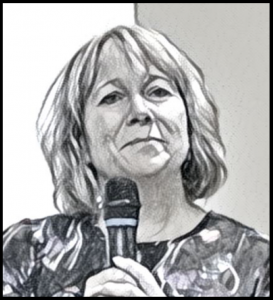 Equality and Diversity Policy red Flags in Schools (and what to do about them).
Equality and Diversity Policy red Flags in Schools (and what to do about them).
SSAUK is a national group of parents, teachers, governors and professionals dedicated to putting safeguarding at the heart of its activism. SSAUK will talk about how it is focused on working with schools and educators to ensure school policies meet the safeguarding needs of all students while taking into account the protected characteristics of the Equality Act.

Tracy introduced herself as having been ‘radicalised on mumsnet’ and said that being a mother to two girls was the reason she became involved, challenging both her child’s school and the British Gymnastics trans policies. SSA is currently challenging Oxfordshire County Council’s policy. The group started with about 100 women in Oxford but grew to be a national organisation. SSA was involved with challenging the NSPCC over the Munroe Bergdorf scandal, and was (of course) immediately accused of being right wing. It is currently involved with challenging the NHRC guidelines, which schools are currently awaiting. SSA is also involved with campaigns concerning the acceptance of pornography and hope to be able to provide resources for people to challenge their schools when policies do not centre safeguarding.
“Everything we put out is credible, evidence based and puts the child at the heart of it… safeguarding first is our motto.”
Many of the campaigns they are involved in can be seen on the SSAUK website.
Red Flags
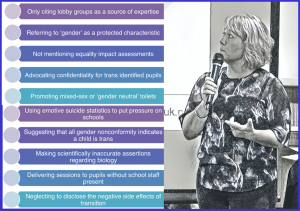
Shaw emphasised the importance of asking schools if they have done an equality impact assessment on any policies which they have adopted – it’s the school’s responsibility to do an assessment, although many think the council has to do it. A policy must not impact anyone within the protected characteristics and policies must be compatible with each other: for example a confidentiality policy should be compatible with the safeguarding policy. Most schools will not have done an impact assessment.
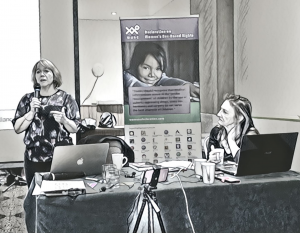 Schools, she believes, are usually happy to discuss these issues with parents, although they tend to believe translobby guidance- for example Stonewall’s statistics on suicide- until they are explained to them.
Schools, she believes, are usually happy to discuss these issues with parents, although they tend to believe translobby guidance- for example Stonewall’s statistics on suicide- until they are explained to them.
SSA is concerned that teachers are encouraged to look out for gender non-conforming behaviour, and even ‘flag’ the behaviour of five year olds which is ‘deeply, deeply sexist‘.
Shaw recently read a guidance policy which suggested that schools should recommend that girls might want to bind their breasts to alleviate dysphoria. How, she asked, can that pass safeguarding policies?
Find out what your school’s policies are. Talk to other parents. Writing letters is important, Tracy concluded, keep letters short and to the point and ask questions to which they have to give answers. If you don’t get those answers, pursue a formal complaint. Persevere.
“It’s a marathon, not a sprint.“
Questions
Someone asked if letters were better than emails and Shaw suggested writing letters and following them up with emails. One woman pointed out that the high percentage of autistic girls wanting to transition should be of great concern. Her autistic daughter, who was having problems with puberty, came home and asked, “Can’t I just take those blockers? Everyone knows about them.” It was observed by a parent, doctor and school governor that a diagnosis of gender dysphoria was being made by teachers, who then made decisions about how the child should be treated before the child had even visited a doctor. The fact that high numbers of trans-identified girls had suffered sexual abuse was also raised. One woman said that, after she spoke to them, her child’s school had agreed to do work on the difference between sexuality and identity before introducing trans issues. Another said that her child’s school refused to share the reading list for RSE classes. It was recommended that before a meeting with your child’s school you put your issues in an email in advance so thy know the questions you wish to have answered. Someone expressed how disappointed she was in Stonewall when there was still so much homophobia among parents.
Lunchtime
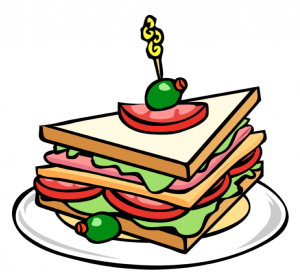
Stephanie Davies-Arai:
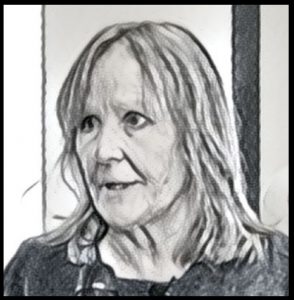
‘The Transgender Child: The Creation of an Emblem for a Political Movement’
The organisations who are influencing clinical practice and dictating guidance for schools are not neutral child support groups. Rather, they are political lobby groups who campaign to change society to fit an ideological agenda to replace sex with ‘gender identity’ as the distinction between men and women.
“Stephanie is a communication schools expert, teacher trainer, parent, coach and author of the highly regarded book, Communicating with Kids.” Maureen told us in her introduction. “She is an experienced speaker on parenting, feminism and transgender children and has made regular contributions to the House of Commons. She founded the organisation Transgender Trend in 2015 and has produced comprehensive guidance for supporting gender-variant and trans identified children in schools, for which she was shortlisted for the Ford Maddox prize.”
Stephanie set up Transgender Trend after realising that there was no voice of challenge in the media. Transgender Trend took off very quickly. Concerned that parents who looked online were only accessing guidance and propaganda form organisations like Mermaids and Stonewall, who would tell them ‘your daughter is now your son’. She felt that parents needed access to information based on facts and research.
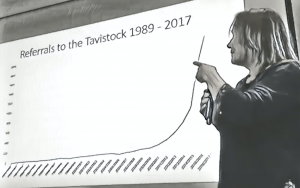
“This is why I call it a trend.”
“I’ve been critcised for calling the organisation Transgender Trend,” apprised Davies-Arai, “but this is party why I call it a trend. Trend is a neutral word and it shows what we see happening globally with referrals to gender identity clinics.”
It was also the search term that parents told her they were putting into Google when looking for information on transgender kids. She developed the guide for schools because other organisations were producing theirs and she wanted something that parents could take into schools as an alternative and say, ‘have a look at this, this is different and I think this is better.“
Transgender Trend have also produced a document on safeguarding concerns within the toolkits produced by trans organisations across the country and promoted by the DOE.
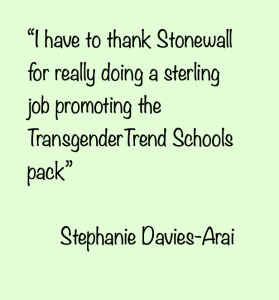 Davies-Arai can’t speak about the national schools guidance of the Equalities and Human Rights Commission National Schools Guidance, because she is a stakeholder. She can, however, discuss the leaked Scottish guidance.
Davies-Arai can’t speak about the national schools guidance of the Equalities and Human Rights Commission National Schools Guidance, because she is a stakeholder. She can, however, discuss the leaked Scottish guidance.
The Transgender Trend schools pack was published in February 2018 and Stephanie said she wanted to thank Stonewall for promoting the Schools Pack to all the local authorities – by telling them not to use it.
Davies-Arai notes that we have changed the language we use when speaking about children with gender dysphoria. The term ‘transgender’, she observes ‘establishes conformity as the rule’ and teaches children that “if you transgress the gender rules for your sex you must go over to the other side and identify yourself as the opposite sex.” A child whose transgression is not that extreme is expected to identify as non-binary. This regressive, misogynistic philosophy is being promoted by schools and local authorities at the behest of political organisations who provide training for the police, home office and numerous other organisations. These groups promote affirmation and transition as the only pathway for children with gender dysphoria, and want to see the definition of man and woman changed in law.
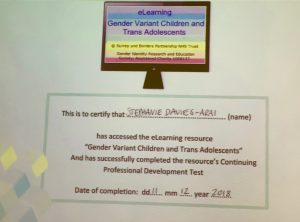 In a tongue-in-cheek heads-up to those who said she was unqualified to speak on the subject of trans kids, “as if trans kids were some magical beings that are different to every other child“, Davies-Arai completed the GIRES e-learning ‘Gender-Variant Children and Trans-Adolescents‘ course, noting that she now had the same qualification to talk about trans-kids as GP Doctor Helen Webberley. This announcement was met with laughter and much applause as Stephanie added, “Of course, in order to pass this course, I had to answer every question wrong.“
In a tongue-in-cheek heads-up to those who said she was unqualified to speak on the subject of trans kids, “as if trans kids were some magical beings that are different to every other child“, Davies-Arai completed the GIRES e-learning ‘Gender-Variant Children and Trans-Adolescents‘ course, noting that she now had the same qualification to talk about trans-kids as GP Doctor Helen Webberley. This announcement was met with laughter and much applause as Stephanie added, “Of course, in order to pass this course, I had to answer every question wrong.“
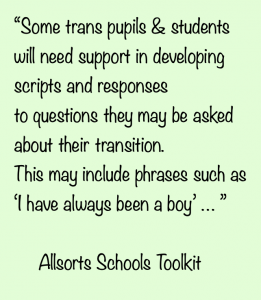 GIRES claims that male and female describe sex, but man and woman describe ‘psycho-social and cultural factors’ and hence gender identity, not sex. This is the denial of biological sex.
GIRES claims that male and female describe sex, but man and woman describe ‘psycho-social and cultural factors’ and hence gender identity, not sex. This is the denial of biological sex.
The Allsorts School toolkit, promoted by Mermaids, GIDS and the NEU gives this advice to sex education teachers: “In labelling the genitals make it clear that most boys, rather than all boys, have a penis and testicles”.
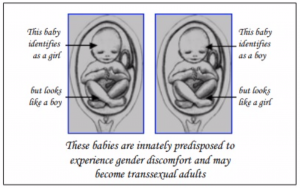
The innate gender identity model
The GIRES theory is that there are ‘pink’ brains and ‘blue’ brains and that these can end up in the wrong body. Being transgender is being your true, authentic self. Schools are not just being asked to-very rightly- include trans pupils and ensure there is no discrimination, they are being instructed to take part in the model of affirmation and transition. Teachers are told that trans pupils must be referred to, and treated as, members of the opposite sex under all circumstances, including situations involving toilets, changing rooms and sports. 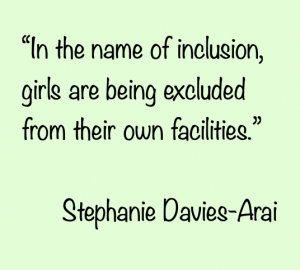
Yet, Davies-Arai asserts, schools do not have an obligation to teach gender identity, which is not a protected characteristic. Sex is the distinction between boys and girls and distinction between sex and gender should be adhered to.
This policy of inclusion erases sexual boundaries, teaching teenage girls that if they express discomfort at changing in front of a male classmate, they are either a prude or a bigot. Girls know that they will risk social exclusion if they express this objection. This is coercive control, a serious safeguarding issue and removes the principle of consent, making the breaching of sexual boundaries a school policy.
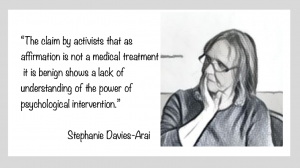 Groups such as GIRES and Mermaids push for the ever younger transition of children, and ever younger access to puberty blockers, promoting the idea that young people will self-harm without them.
Groups such as GIRES and Mermaids push for the ever younger transition of children, and ever younger access to puberty blockers, promoting the idea that young people will self-harm without them.
“Medical intervention is very important, especially for teenagers who are already in puberty. It’s absolutely vital.” Susie Green, The Guardian 2015
Recent studies in a Dutch clinic current showed that social transition was the biggest predictor of persistence of gender dysphoria, and that it can make it harder for a child to transition back. The same clinic recognises that whilst blockers are meant to offer thinking time, many adolescents experience them as the essential first medical step in their transition.
“You need to take puberty blockers so that essentially as an adult you will ‘pass’ better as the opposite sex. This is transgender doctrine and these decisions are made on the basis that cosmetic appearance is more important than biological function. So children stand to lose their fertility and their sexual function, but as long as they look good, that’s all that matters.”
Trials had not been done on puberty blockers to find out if they were safe to take at the time of natural puberty and current trials on sheep are indicating they may have irreversible effects on the brain.
“Schools need to know,” concluded Stephanie, “that there is no robust evidence base to support the affirmation and transition of children in schools or the subsequent treatment with puberty blockers.”
Questions and discussion
A representative from the Lesbian Rights Alliance said they’d been contacted by a number of parents of young lesbians who had been sucked into trans ideology. Bullying, misogyny and sexual abuse can all play a part and teachers need to recognise this. A woman from Sweden, from a network of parents, professionals and detrasitioners said Sweden was struggling with the same issues and we needed to reach out and do this together. Helen Joyce suggested we stop ‘playing nice’ and start taking strategic legal actions and that lawyers will be needed to back this up. Marcus Evans said GIDS is the only service that takes no interest in follow ups and plays by different rules than the rest of the Trust.
It was noted that we were running over time. Stephanie reiterated that everything to do with transgender seems to fall outside of the normal rules. She said it was fantastic that the LGB Alliance had sprung up and that could make a difference for young lesbians. She wished she had had more time to look at the scandal of transitioning autistic children, and had more time to talk about the transition of boys.
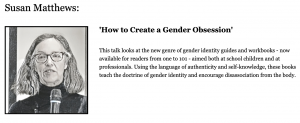
Matthews began by telling us the true story of two small boys, ‘Arthur’ born in the early 90s and ‘Billy’ born 25 years later. Matthews tells us that whilst she knows both these children, she might as well have invented them as they are such perfect examples of what she wants to talk about today.
Arthur was 4 in 1995. He’s the youngest of three children, with two rather flamboyant older sisters. By the age of 4 it’s striking that Arthur loves dressing up – especially wearing his older sister’s pink tutu and sparkly shoes. No one makes a big deal about this. He is not taken to the doctor or a gender specialist in fact no one has heard about gender specialists for little boys who like tutus in the 1990s. (They exist but mostly they sit in an empty office and see just a handful of children a year). There is some discussion about whether Arthur should go to nursery in a tutu. In the end the mother simply chooses him androgynous clothes in the brightest pinkest most flowery colours she can find. And they go on like this very happily until one day, when Arthur is 11, his mother comes home with a flowery sweatshirt and Arthur says; ‘I don’t want this. I want a navy blue one.’
We know how Arthur has turned out. Aged 18, he is a markedly feminine boy. He is happy exploring his identity and his sexuality. He may well be gay – but that’s his business.
Billy, who was 4 last year is a child of the 21st century. He loves pink shiny backpacks and wears a rainbow skirt and lycra leggings. His mother knows that she has a trans kid and has educated granny and the nursery about the need to affirm his identity as a girl. She has bought him every trans kid book available. And there are lots. She particularly likes ‘Who Are You? The kid’s guide to gender identity’ by Brook Pessin-Whedbee. This is ‘an introduction to gender for ages 3+’, published by Jessica Kingsley (London and Philadelphia). A product of a distinctively US affirmative model of gender, this is the kind of bright attractive book a parent might select. It contains simple affirmations like:
‘The important thing to remember is that you are the one who knows you best.’
The book helps Billy to distinguish between sex ‘assigned at birth’ and gender which is defined as ‘your personal expression – what you like, how you dress and act.’
(Arthur managed this one without a book.)
Billy, aged 4, learns that ‘People say there are only two genders. But there are really many genders.’
He has learned that the word ‘cisgender’ means when ‘someone’s identity matches their sex assigned at birth’. This phrase trips easily off Billy’s tongue at nursery. He has also learned the names of some of the genders he can choose:
‘trans, genderqueer, non-binary, gender-fluid, transgender, gender neutral, a gender, neutrons, bigender, third gender, two-spirit’.
Billy’s granny has been educated in gender. She’s a bit worried that the mother is already discussing possible later medical intervention but she’s talked to a therapist friend who explained that puberty blockers may well help when Billy is older. She knows that blockers provide a ‘breathing space’ and a ‘pause button’ that help a child to decide whether to go ahead with cross sex hormones when the time comes.
 Matthews concludes her story and turns to the audience.
Matthews concludes her story and turns to the audience.
“There’s no doubt that there has been a change in how we respond to kids who display cross gender identification and who are gender nonconforming in the last twenty years.“
This has resulted in a culture obsessed with gender, that actively teaches gender ideology, online and in printed form.
The book mentioned above talks of ‘gender assigned at birth’ and contains such inspirational lines such as “babies can’t talk so grown ups make a guess by looking at their bodies.“
A ‘Wikihow’ page contains an article called : ‘Talking to a Child you believe may be Trans’.
 Advice includes: ‘Leave around a few books with transgender characters.. if they seem like they want to come out, but are too shy, it’s time to initiate the conversation… Remind them of one of the transgender books, and ask if they have ever felt that way…’
Advice includes: ‘Leave around a few books with transgender characters.. if they seem like they want to come out, but are too shy, it’s time to initiate the conversation… Remind them of one of the transgender books, and ask if they have ever felt that way…’
If that doesn’t work, a more direct approach is suggested: ‘I’ve noticed that you like long hair and feminine things. Have you ever felt like you are actually a girl instead of a boy?”
This was met with groans from the audience.
“Every time you think you’ve heard it all,” muttered a woman behind me.
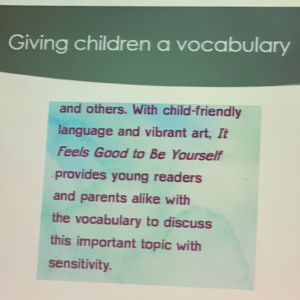 There are lots of these books, Matthews asserts. It is almost as if publishers have decided they need a book about a trans child. These books claim to give the child the language they need to express themselves, but it seems that the child needs to speak specifically with the language that they are given, and are only listened to when they say what the adult wants them to say. This she describes as “the imposition of adult categories on the child’s experience.”
There are lots of these books, Matthews asserts. It is almost as if publishers have decided they need a book about a trans child. These books claim to give the child the language they need to express themselves, but it seems that the child needs to speak specifically with the language that they are given, and are only listened to when they say what the adult wants them to say. This she describes as “the imposition of adult categories on the child’s experience.”
She notes the endless repetition of the word ‘gender’ in these books. The Gender Quest Workbook for teens and young adults begins by asking: “What is gender anyway?” going on to tell young people “Gender can be challenging to wrap your head around because many of us don’t have all the information about what gender really is (or isn’t), or we have information which isn’t completely correct.“
“You remember we were going to listen to the child?” quips Matthews. “I don’t think so, no. This book pays lip service to the idea that the child knows best, whilst at the same time imposing a gender catechism to be learned by rote.”
“Gender is your deep-down feeling that you’re a boy, a girl, neither, both, or something else.” the book tells seven year olds, excitedly. “That’s right! Not just a boy OR a girl – some people know themselves to be BOTH boy and girl or NEITHER boy nor girl or SOMETHING ELSE altogether. There are so many genders, and the expert on your gender is YOU!”
Capitalisation and exclamation marks, points out Susan, reveal the authoritarian tone, deployed paradoxically to insist that the child is the expert.
I thought of my old gran, who always insisted that anyone who wrote in capitals was bonkers.

The book for teens ‘Can I tell you about Gender Diversity: a guide for friends, family and professionals‘ is characterised by the same kind of crude didacticism. In it a 12 year old girl called Kit, had doctors who ‘assigned her female‘ at birth, therefore her parents raised her as a girl.
‘I didn’t like playing with dolls, or wearing dresses, and I hated having long hair‘, Kit tells the reader.
Kit goes on blockers which ‘stop my body developing in ways that make me unhappy’. She applies for a new passport and tells the reader that when she’s 18 HRT will ‘ mean that I’ll start to develop facial hair, and my body will go through boy puberty’.
This of course is a dangerous lie. Kit’s body will not ‘go through boy puberty’.
Matthews notes the ‘mind-numbingly repetitive nature of gender ideology’ and how ‘poor Kit appears to live in a 60s time warp’. She is struck by the fact that while the book is supposed to be the voice of a 12 year old child it is actually the voice of a 28 year old ‘non-binary’ adult.
“These books are as crudely didactic as the worst of 18th and 19th century children’s literature.”
Matthews moves on to discuss the ‘really lovely, very classy, beautiful‘ book ‘Julian is a Mermaid‘ which tells the story of a boy named Julian who loves swimming and mermaids. Travelling on the subway with his Nana he sees three women dressed as mermaids. When he gets home he improvises a mermaid costume with ferns and flowers for a headdress and a curtain for a skirt or tail. His Nana takes him to see the Mermaid procession. This is a story about a boy whose desire to dress up is cherished by his Nana.
Nowhere in the book does Julian say he is trans, or a girl, or that he wants to transition when he grows up.
The ‘Common Sense Media’ review calls it ‘a story about a boy who wants to be a mermaid that will resonate with all kids who have secret dreams’. It also tells parents that the Mermaid Parade is a real event in New York City. The review emphasises culture and community, imagination and fantasy. It reads Julian like Arthur in the stories at the start of Matthew’s talk.
Is Julian like Arthur, questions Susan, “who loves dresses and may turn out to be gay (or not) or is he like Billy, the trans kid who is already destined, age four, for puberty blockers?”
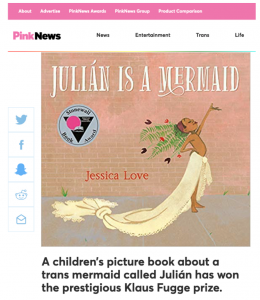 Pink News has a very different take.
Pink News has a very different take.
“You can see how the cultural obsession with the figure of the trans child makes that journalist unable to read the book, he simply can’t see what’s in front of him.”
The Guardian calls the book a ‘rebuke to bigotry‘ and the Telegraph claims, ‘‘Love’s win falls in a week when an academic (yes, it was Susan!) has claimed that children are being put at risk by transgender books in UK primary schools.’
Whilst Matthews admires the book, she notes that ‘meanings are created by culture, not by individuals.. and in the current climate it is hard for Julian to remain free of the categories that Pink News and the Guardian want to impose on him’.
Where a child might just see the scene in which Julian turns a curtain into a mermaid costume as imaginative play, an ‘informed’ adult may see Julian as trans.
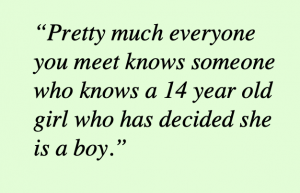 It is this adult agenda that makes the use of these books in schools of concern to Matthews, who adds “the concerns that we express are not a ‘moral panic’. A gender nonconforming girl such as Kit is overwhelmingly likely to grow up to be a lesbian if she avoids medical intervention which will distort her sexuality and hinder her fertility.”
It is this adult agenda that makes the use of these books in schools of concern to Matthews, who adds “the concerns that we express are not a ‘moral panic’. A gender nonconforming girl such as Kit is overwhelmingly likely to grow up to be a lesbian if she avoids medical intervention which will distort her sexuality and hinder her fertility.”
“My story,” concludes Matthews,“is a story about the closing down of culture and the limitation of meaning.”
Questions
Someone asked if Susan would write a story about a gender non-conforming child who wasn’t transgender. Susan agreed that one was needed. The CBeebies and Radio 4 dramas affirming trans ideology were mentioned and it was agreed that there was a need for modern stories about children like Pipi Longstocking. Stephanie of Transgender Trend spoke up and said that they were working on an early years book called ‘My Body is Me‘ which should be out in December.
Another ‘comfort break’ was scheduled. I dashed off to grab a coffee from the bar upstairs, passing through a hall filled with excited conversation. When I returned it was time for the final speaker.
Charlie Evans:

Charlie Evans is the founder of the Detransition Advocacy Network, the first charity launched to help and support detransitioners. DAN will be officially launching in Manchester at the end of November and can be followed on Twitter @DetransAdNet.
“I’m not a philosopher or a gender expert, or a psychologist but I speak from first hand experience,” started Charlie. She spoke of the system that, instead of celebrating gender non-conforming women and girls, has pushed them into boxes and diagnosed them with a condition treated with hormones and surgery. Girls whose “personality and clothes and hobbies are seen as a symptom that they were born in the wrong body.” Stonewall, Mermaids and the NHS have sold this lie to girls who have undergone medical treatments, and then when they desisted were told they were ‘never really trans’, just misdiagnosed.
When Charlie began speaking out about her experience she was contacted by hundreds of young women, many whose bodies had been “altered by the scalpel in an attempt to make them fit.” These are human rights violations even if they are presented as progressive and liberal. Detransitioned girls are not weak, asserted Evans, but indoctrinated, often from the moment they started school. ‘If you do not feel like a woman, you are not a woman’ seems to be the most commonly held view in feminism.
“Imagine a girl, taught to perform femininity at every turn but always hating it… being catcalled by men and groped in nightclubs seems the norm… she’s allowed to box but she’s laughed at for punching like a girl.. she wants to be handsome… she wants girls to look at her the way they look at boys. She starts to say and at some level believe, that she’s a boy. In a healthy society this girl would be encouraged to stick her middle finger up at the boys and embrace her body as it is… but today a child like her is recognised as transgender… She continues to say she is a boy and she is continually affirmed. She knows she’s a boy because she doesn’t act like a girl… by now she knows she’s a boy because she meets the diagnostic criteria for gender dysphoria.”
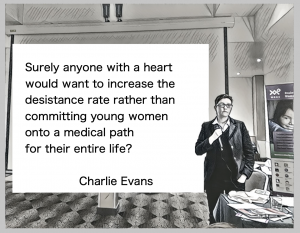 Evans believes that transition is a gamble and that there is no real evidence that transition eases dysphoria better than therapy for self-hatred and sexual trauma (where necessary) combined with support from family and friends. A girl forced to conform with feminine gender norms will of course feel unhappy. Would transition make her more happy than the freedom to be herself and embrace her hobbies?
Evans believes that transition is a gamble and that there is no real evidence that transition eases dysphoria better than therapy for self-hatred and sexual trauma (where necessary) combined with support from family and friends. A girl forced to conform with feminine gender norms will of course feel unhappy. Would transition make her more happy than the freedom to be herself and embrace her hobbies?
“It’s criminal that there has been such a lack of research into ways to treat gender dysphoria. Surely when faced with changing the bodies of the gender non-conforming to fit society or changing society to fit the gender non-conforming, we should be fighting for the latter.”
Surgery is the true conversion therapy of the 21st century, suggests Evans, asking why there are no studies and no research into other options to medication and surgery, when that treatment and its results are so extreme. Gay conversion, she says, is still thriving today.

The final discussion
One woman said she’d never seen such sustained attacks for speaking out as those against Charlie Evans. Evans said that the attacks on her as a desister were planned to silence more vulnerable detransitioners, adding that she knew a 21 year old girl who had full surgery on the same day as the conference.
“When everything is to be treated as a commodity,” mused David Bell (ex governor of the Tavistock Foundation), “the only measure of it is whether you want it or not. Press a button, like, don’t like… the child is being encouraged to treat their body not as a complex thing but as something that they ‘like’- press the button- or ‘don’t like’… what the consumer wants is what must be true… somehow gender has got caught up in this violent movement which hates, more than anything, with paranoid intensity, the idea of thoughtfulness.”
Evans said that gender ideology had even reached the ‘experts’; that she herself had two degrees in Biology. It took the right person to say the right thing to make her question gender ideology . She was asked by Helen Joyce if there was one thing that she felt could be said to someone trans-identifed to make them question gender ideology. She replied there probably was no one thing, although the fact that her parents let her dress as she liked and didn’t force ‘girl’ behaviour on her probably helped, giving her less to kick back against.
Bob Withers emphasised the importance of detransitioners speaking with people who were planning transition, and the influence this could have on those considering transition themselves. Evans agreed this was important, calling it a ‘sugar coated movement’ referring to how double mastectomies were rebranded as ‘top surgery’. How did Evans plan to protect herself psychologically against the attacks against her?
“Gin,” she replied, laughing, bravely making light of the death threat she has received, adding, “I live with supportive people; I’ve got a very, very good therapist; I drink a lot of gin.”
A woman spoke of the large numbers of autistic girls caught up in the gender movement and said it was important for those who could to speak up to do so and offer an alternative view. Evans said that she didn’t think transition was wrong for everyone, or that there was any one way to help a child. Another spoke of hearing a program on Radio 4 which did not consider other options as to why a child might be confused about gender; she said she had written to express her feelings about this and would encourage others to do so.
The next reply is from a young detransitioner, in answer to the question ‘what can friends and parents do?’
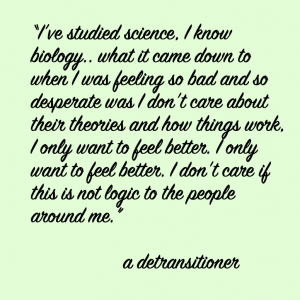 “As a detransitioned person myself, the question what can you say, what can you do as a parent- it’s definitely super-complicated… the thing that started to make me critical of the three years of identifiying, and starting hormone treatment, it was a meeting with a person who had been transitioning for a while. This person said things I’d never heard before and because it came from that person I knew there was no secret agenda behind it, so that definitely had an impact. I also wanted to add when I was in that mindset… I knew it was not logic in some way.. I’ve studied science, I know biology.. what it came down to when I was feeling so bad and so desperate was I don’t care about their theories and how things work, I only want to feel better. I only want to feel better. I don’t care if this is not logic to the people around me. If there is anything someone as a parent or a good friend that someone can question… it’s not, to start with, gender theory, it’s more if you can have a discussion about the evidence. ‘Where does it come from that all the transitioners are happy?’ Because that’s what I thought. ‘Where does it come from that they live healthy long lives?’ I think that’s where you actually can start. We need to debunk this romanticised picture as to how well this all works. Then you can talk more about stereotypes, but start by understanding, this won’t make me feel better.”
“As a detransitioned person myself, the question what can you say, what can you do as a parent- it’s definitely super-complicated… the thing that started to make me critical of the three years of identifiying, and starting hormone treatment, it was a meeting with a person who had been transitioning for a while. This person said things I’d never heard before and because it came from that person I knew there was no secret agenda behind it, so that definitely had an impact. I also wanted to add when I was in that mindset… I knew it was not logic in some way.. I’ve studied science, I know biology.. what it came down to when I was feeling so bad and so desperate was I don’t care about their theories and how things work, I only want to feel better. I only want to feel better. I don’t care if this is not logic to the people around me. If there is anything someone as a parent or a good friend that someone can question… it’s not, to start with, gender theory, it’s more if you can have a discussion about the evidence. ‘Where does it come from that all the transitioners are happy?’ Because that’s what I thought. ‘Where does it come from that they live healthy long lives?’ I think that’s where you actually can start. We need to debunk this romanticised picture as to how well this all works. Then you can talk more about stereotypes, but start by understanding, this won’t make me feel better.”
“I still have gender dysphoria,” added Charlie, shortly afterwards. Charlie’s doctors had offered her medical transition when social transitioned hadn’t helped her. She feels that it’s important that more funding should be put into looking at gender dysphoria and more research should be done.
“People who’ve transitioned and people who detransition should be closer together. I don’t ‘misgender’; I do my best to respect everyone; if we had the same in return I think we could offer each other a lot.”
Maureen wrapped the meeting up by asking if there were any more questions for the speakers, and then suggested we should take some time to discuss ideas moving forward. She reminded us to look at the Declaration; sign it if we agreed with it and share it with our networks.
Heather suggested that after the final few questions we should all go and have a drink in the bar and this idea was met with much approval.

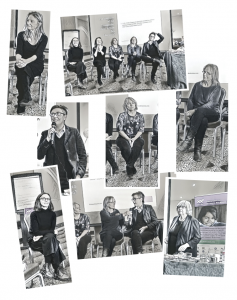
It was suggested that the phrase sex dysphoria makes a lot more sense than the phrase gender dysphoria.
A request was put out on behalf of Fair Cop for screenshots of any evidence of training given to the police by trans lobby groups. Fair Cop is campaigning for the College of Policing to change its Hate Crime Guidance.
Someone asked how to contribute to Charlie’s charity and she said that she’d recently lost 14 clients out of 15 and now had no job. Heather clarified that any assistance to help Charlie through until January would be much appreciated. Evans doesn’t charge for giving talks and promised not to spend any donations on gin 🙂 .
You can support the DAN with a Paypal donation sent to [email protected] or you can support Charlie personally with a payment to [email protected].
A woman from Scotland spoke about LGBT Scotland who provided guidelines for schools, and informed us that some Scottish women were campaigning to get those guidelines changed. There was some discussion about the meaning of ‘case by case’ but I’m afraid I got a bit lost.
The importance of helping children disconnect from technology was mentioned, and veganism was touched on. The inherent agesim in misogyny was discussed, and how liberal feminism markets ageism to young women. Later, a woman spoke of the difficulty of applying for funding for projects for young lesbians when funding is not given to projects that are lesbian only.
“This movement is being sold as a youth movement but it is not: it came from the academy, it came from old transactivists and it’s been systematically taught to children.” pointed out Stephanie. “I think children have been explicitly, directly targeted because children are needed… the efforts that they’ve made with children are bigger than any other movement I’ve seen. The guidelines for schools, the working behind the scenes… it’s not a youth movement, but young people think it’s a youth movement because that’s part of the propaganda that’s been sold to youth… but young people themselves are not stupid. At some point they will realise: ‘this movement, that we rebels are taking forward, is actually being taught to us by our teachers’.”
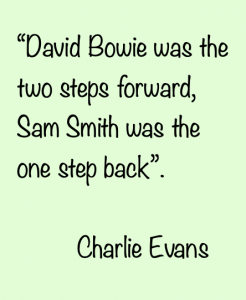
“We aren’t taught anything in school about feminism beyond the suffragettes,” agreed a young woman. “We’re taught feminism includes men and it includes whoever feels like a woman and that that’s progressive.”
“In the 1980s and early 1990s,” said Brunskell-Evans, “culture became pornified and sexualised and feminists were repackaged as repressed, bigoted people. Actually, we WERE the sexual revolution. We started it! There’s something awful about this, that young women are being set against older women.”
Another woman disagreed. She said her lesbian group had a number of younger women in it, some of whom had said meeting older women had stopped them contemplating transition. She said she didn’t feel that they despised older women. Another pointed out that her daughter’s university feminist society was for ‘feminists of all genders’ and that this now seemed to be the norm. Later, a woman pointed out that young women at at least one university had managed to establish a woman-only feminist society, although it had been a lengthy fight. She added that she found hope in the fact that among people who haven’t been to university, gender ideology is not accepted: “we need to have faith in the ordinary people who know that it’s bollocks”.
Marcus Evans asked what the position for men was in this movement. He recognised the indoctrination of children and the massive attack on feminism but said the attack was not just on women. “Some of us would like to be involved in some way and play a helpful role.“
The importance of educating children about the realities of gender ideology was emphasised. It was suggested that it would be more helpful if the Tavistock explained that there were two different perspectives on gender, one that it was a feeling inside and another idea that it’s an external influence.
“I sent Polly Carmichael an email,” offered Stephanie “explaining exactly what the hierarchy of oppression is, but she didn’t reply to that.”
Sheila Jeffreys spoke of attending a meeting of the Feminist and Women’s Studies Association where ‘a man pretending to be a woman called Ruth’ claimed that WPUK was ‘funneling hatred from the extreme right into the women’s movement‘.

The slogan on Sheila’s friend’s T shirt: ‘made by a Nazi’.
The title of the conference was ‘Feminist Dilemmas, Feminist Hope?’ and at question time, Sheila’s friend had raised the subject of the war on women by men pretending to be women. A ‘most extraordinary disruption‘ ensued, said Sheila, her friend was asked to leave and when she refused everyone else walked out. Ruth shouted in her friend’s face, “You are wearing a T shirt made by a Nazi!“
A chant of “Shame, shame on you!” was set up by ‘the new generation of young women’s studies researchers and teachers in university’.
“I just thought I should tell you how far this has gone,” concluded Sheila. “The only possibility for young women is to revolt, and some of them are.”
“This is the perfect push back against women,” added one woman, “by redefining what women actually are. It’s a perfect storm, driven by capitalism and neo-liberalism.”
A woman, whose daughter had come out as trans at 15, described herself as an ROGD parent. She said at the time she’d had nowhere to go and was let down by the NHS, but had found groups that given her support and an alternative view. She and others had started a group called Our Duty. “My daughter isn’t out of the woods,” she added, “but she needs radical feminism, not testosterone!”
Finally, it was observed that conference attendees were a diverse group of people. This struggle includes different groups of people, parents, grandparents, young people, gay, straight etc… and it is vitally important that we stay together on this, try to avoid infighting, and learn from each other.
Maureen O’Hara thanked the speakers and attendees, reminding people that they could be put in contact with each other if they wished to be, and emphasising the importance of a broad-based network .
We retired to the bar.
I wished I’d brought more crisps with me.

New Relationships Education, Relationships and Sex Education (RSE) and Health Education (England) Regulations will come into force in schools in September 2020.

 Maureen O’Hara:
Maureen O’Hara:
Pingback: Inventing the Transgender Child conference – Stop The Trans Section 28
You are perpetuating hate and persecuting women and children. You are putting children at risk. How dare you pretend that this hate you spread is in aid of protecting women – you are ignorant and misinformed.
Transgender women are women. Transgender girls are girls. Transgender men are men. Transgender boys are boys. And, beleive it or not, there are also plenty of people who don’t sit on these binaries, who are between gender binaries. This happens biologically, yes, but it also happens to biologically conforming individuals (there are as many intersex individuals born each year as there are redheads) whose phsychology does not align with their x or y chomosomes.
Trsansgender women and girls, boys and men, and non-binary people are the individuals who are most at risk of sexual violence in our society, not cis-gendered women as you appear to beleive. Look at the actual statistics! Listen (actually listen!) to peoples stories and experiences (now and through the ages). And this risk comes from people like you who fan the flames of intolerance and misinformation. Shame on you.
And to address a massive misconception, nobody ‘decides’ to be transgender. Becasue people like you make it an extremely hard path to walk. Shame on you. Yes, most people know a transgender person. But look back through history and you will find that transgender people have always been there. Accross all cultures and throughout all times. This is nothing new! The differenc is that we have learned the danger in forcing people to hide their true selves or to conform to something that they CANNOT conform to. The difference is that we are accepting this reality and doing our best to remove the dangerous tabboos about it that people like you are so desperately trying to keep alive.
These taboos cost lives – lots of lives. Due to people like you, transgender youth are by far the single group most at risk of suicide of all. This is not an intrinsic risk – it does not come from within transgender people themselves but instead it comes from them being ostracised, rejected, gaslighted and misunderstood by family, friends and broader society. It comes from people like you!! Look at the proof of this. If there is full and loving support for the transgender child from within the family unit, this risk of suicide immediately drops to much, much closer to normal levels. If there is broad spectrum support, including from wider family and friends and a supportive community, this risk of suicide drops to be equal to that of cisgender youth. It is the attitudes and hate speach of people like you who are killing our young transgender people. Shame on you.
In mourning the rise of out, proud and supported trangender youth and the rise of their acceptance socially, you are actually instead wishing for a time when the ‘better option’ for these young people was either to live in torment or to kill themselves. I guess that would make you more comfortable. More transgender suicide = less transgender people = you feel better. Shame on you.
Likewise, such ignorance and bigotted attitides as those you seek to perpetuate are the justifications that their attackers use when they take their hate out physically on transgender and non-binary people. These ways of thinking fuel their feelings of entitlement to violate and mutilate and worse. Shame on you.
Why are you so fixated on other peoples’ gender? You are the people who are gender ‘obsessed’. Transgender people simply need to be who they are – that does not need to be a big deal at all, unless people like you – people who can’t live and let live – make it into one. No, transgender people are not gender obsessed. This includes transgender people who are on daily hormones. They are no more gender obsessed than a diabetic is ‘insulin obsessed’, and should be no more defined by the fact thse hormones are taken rather than naturallly produced than a monopausal or post menopausal moman on Hormone Replacemen Therapy (HRT). Or do you beleive that women on HRT are also living a sham and should be taken off it, even if that throws their lives into a tailspin?
Please open your narrow mind and LISTEN to people’s reality. My story: At the birth of our eldest child we thought we had a beautiful son. At age 3 my child began to ask “when will I turn into a girl?”. To be clear, we never put any emphasis at all on gender and have always taught both our children than “there are not ‘girls colours’ or ‘boys colours’ but colours for eveyone to enjoyu, nor ‘girls toys or games’ or ‘boys toys or games’, just toys and games. We never promoted gender or tried to fit our kids into a too tightly gendered niche, but just did our best to allow them to be kids. However, by age 7, my beautiful and eloquent eldest child explained to me that it wasan’t about what she wanted to be able to do, or wear, or play with, but that is was deeper inside of her – it was about who she is, and that she is a girl. NOBODY had ever spoken to her about this, or coached her on how to feel or what to say. She had never heard the term transgender. And yet she knew who she was. This has persisted, despite her unfortunately experiencing some bullying, ignorance and intolerance, including at very sensitive ages when the urge to conform to what is presented as ‘normal’ is strong. This is NOT a choice for her, and if she was able to choose, this is NOT what she would choose. It is who she is. My husband and I fully accept that we have a beautiful eldest daughter and, like all good parents, we will do everything we can to protect her. You, on the other hand, are actively putting her -and so many others – at completely unnecessary risk.
Please stop it! You are dangerous. Please, please, please stop it!